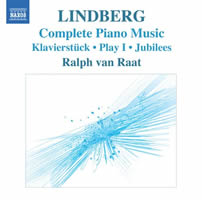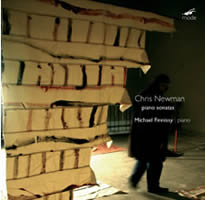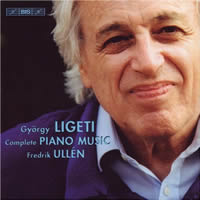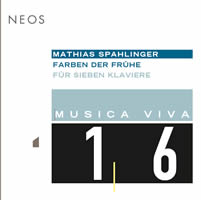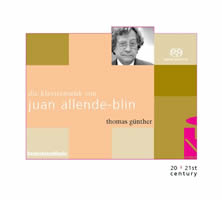Piano Factory 3.
|
Grant Chu Covell [December 2008.]
J.S. BACH: Partita in D Major, BWV 828 (ca. 1726-30); French Suite in D minor, BWV 812 (ca. 1722). Pierre BOULEZ: Notations pour piano (1945); Incises (1994, rev. 2001). David Fray (pno). Virgin 00946 385787 2 7 (http://www.virginclassics.com/). Fray offers a dreamily Romantic spin through a Bach keyboard Partita and Suite arranged around two snappy Boulez items. The contrasts offer the pianist challenges, regretfully unexplored here. We lurch from BWV 828’s energetic final Gigue to the hyper-expressionistic, aphoristic Notations (12 pieces with 12 bars each), then whiplash back to Bach’s Germanic French Suite. A surprising follow-up to the Suite’s somber close, the frenetic Incises begins as if the piano has rolled away. Upon consideration, Fray’s programming makes sense: Both composers, lording over their respective periods, required and require subsequent generations to instigate new styles and techniques. While Boulez’s two may reflect characteristic practices (reusing works, leaving others unfinished), the student Notations (five have been reframed for large orchestra) and the pent-up Incises (elaborated into Sur Incises for pianos, harps and percussion) don’t represent the enfant terrible’s super-serial compositions. I’m all for interesting programs and mixing it up, but at 67:54, another “B” (Brahms or Beethoven, maybe even Berio) might have provided an opportunity for Fray to show more personality. Alternating with Boulez’s First or Second Sonata would have equally done the job.
“Complete Piano Music.” Magnus LINDBERG: Musik för Två Pianon (1976); Klavierstück (1977); Tre Pianostycke (1978); Play I (1979); Twine (1988); Jubilees (2000); Etude No. 1 (2001); Etude No. 2 (2004). Ralph van Raat, Maarten van Veen (pnos). Naxos 8.570542 (http://www.naxos.com/). Lindberg’s four earliest piano pieces thumb through the mid-20th-century almanac, from serialism to aleatoric games — as one would expect of mid-70’s works titled Klavierstück and Play. Van Raat (assisted by Maarten van Veen for the two-piano items, Musik för Två Pianon and Play I) provides the necessary sparkle and dynamic variety to elevate these works above musicological footnotes. Lindberg steps into his own shoes with the kinetic Twine, the dancing filigree of which proves absorbing. The six miniatures of Jubilees (for Boulez’s 75th) employ a previous century’s gestures with an ear for fresher sounds, and the Etudes re-examine the flair of old pianistic styles.
Chris NEWMAN: Piano Sonata No. 1 (1982); Piano Sonata No. 4 (1990); Piano Sonata No. 6 (1997); Piano Sonata No. 10 (2004). Michael Finnissy (pno). mode 201 (http://www.moderecords.com/). These aren’t really sonatas — more like backyard experiments with found ingredients. The composer’s and pianist’s analyses aside, here are examples of stuff music literates might ponder but would never actually commit to paper, perform, or record. Curiously, the music pairs well with this Metier Crane release, also performed by an underutilized Finnissy. The first sonata apes Beethoven with sidelong references to Janacek and Ives. The central movement is titled “The dinosaurs roamed the planes in herds.” One wonders, is “planes” a misspelling or a pun? The finale asks the pianist to sing. The Fourth swaps left- and right-hand parts of a C.P.E. Bach opus, with other than piquant results. The Sixth takes one hand of Beethoven’s Les Adieux while the other borrows from another Newman piece. This concoction is more interesting in that the fractured Beethoven sustains more blunt abuse. The second movement is definitely worth a listen. The Tenth replays Schubert songs according to the rhythms of Varèse’s Ameriques. Strongly played by Finnissy, Newman’s music might have been more interesting had he not identified his sources.
“The Complete Piano Music.” György LIGETI: Études pour piano, 1er livre (1985); Études pour piano, 2ème livre (1988-93); Études pour piano, 3ème livre (1995-2001); L’arrache-coeur (1994); Four Early Piano Pieces (Basso Ostinato) (1941); Induló (March) for piano four hands (1942); Polifón etüd for piano four hands (1943); Allegro for piano four hands (1943); Due Capricci (1947); Invention (1948); Sonatina for piano four hands (1950); Három lakodalmi tánc for piano four hands (1950); Musica Ricercata (1951-53); Chromatische Phantasie (1956); Trois Bagatelles (1961); Monument – Self-Portrait – Movement (1976). Frederik Ullén (pno). BIS 1683/84 (2CDs) (http://www.bis.se/). Distributed in the US by Qualiton (http://www.qualiton.com/). “La langue maternelle.” Bela BARTÓK: Out of Doors: Lento, “Night Music” (1927); excerpts from Mikrokosmos (1939). Peter EÖTVÖS: Kosmos (1961, rev. 1999). György KURTÁG: excerpts from Játékok; Splinters, Op. 6d (1971). György LIGETI: Musica Ricercata (1953-55). Dana Ciocarlie (pno). l’empreinte digitale ED13211 (http://www.nocturne.fr/). BIS reissues 1996 and 1998 releases, adding Ligeti’s first pieces and last etudes to make a complete piano set. Ullén shines in the early items, the mostly short works revealing Bartók’s influence and Ligeti’s taste for finely spun lines. The composer’s acid wit reminds the listener of his Cage-like Trois Bagatelles — and this from a composer of a piece for 100 metronomes who claimed in 1961 to have been unaware of Cage’s 4′33″. Musica Ricercata is a particular favorite: The first piece has but two pitches (the second appears only at the very end) and each elegant number increases the collection until all 12 unite in a chromatic homage to Frescobaldi. Ligeti arranged several for the wind quintet, Six Bagatelles. Ullén overdubs himself for the four-hand compositions. All the etudes, plus L’arrache-coeur, which was to have been No. 11, are grouped on the first disc. Despite his dexterity, I find Ullén rather timorous here. Ligeti craves passion, almost recklessness in the face of complex rhythms, canons, and chromatic patterns. The prize for the most inventive packaging of Ligeti’s etudes goes to Pierre-Laurent Aimard’s sampling on Teldec (8573 86584-2) which also shuffles Reich’s pattern pieces with the music of the Aka Pygmies. Aimard brings more grace and humor to the fiendishly difficult music etudes. Ciocarlie’s disc underscores the debt three modern composers owe to their compatriot Bartók. Truth be told, what would contemporary piano music be like if he hadn’t legitimized folk music or hadn’t invented the “night music” genre? Perhaps Stravinsky would have been the first to bring barbaric rhythms to the concert stage; perhaps Crumb would have burst onto the scene fully formed. Bits from Bartók’s primer Mikrokosmos are sprinkled around Eötvös’ homage to Bartók (later orchestrated as Psychokosmos) and all of Ligeti’s Musica Ricercata. Kurtág’s isty-bitsy hommages and modest collection, Splinters, do tantalize. Ciocarlie’s program creates a conversation between Bartók and the younger generation and makes us eager for more.
“Minimal Piano Collection.” Var. comps. Jeroen van Veen (pno). Brilliant Classics 8551 (9 CDs) (http://www.brilliantclassics.com/). You could argue that a “Minimal Piano Collection” ought to be less than nine CDs, but you’d be missing the point. Composers represented are: John Adams, John Borstlap, John Cage, Philip Glass, Simeon ten Holt, Tom Johnson, Wim Mertens, Carlos Micháns, Friedrich Nietzsche, Michael Nyman, Arvo Pärt, Terry Riley, Erik Satie, Yann Tiersen, Jacob ter Veldhuis, Klaas de Vries, and van Veen himself. Did you catch Nietzsche, Satie, and Cage in there? The Cage is a smooth In a Landscape, and van Veen offers only a few parleys through Vexations. Nietzsche’s Wagnerian Fragment an sich ends ambiguously, inviting several repetitions, though it’s not in the same class as Vexations. Nyman and Tiersen occupy a “The Movies” disc even though tracks on the three Glass CDs also derive from the big screen. Van Veen brings unexpected personality to familiar items, delivering Nyman’s Sheep ’n Tides with joyous swagger, whereas Pärt’s Für Alina unfolds icily. There are some gargantuan efforts: ten Holt’s frenetic perpetual motion Solodevilsdance IV nears 35 minutes, Johnson’s An Hour for Piano extends as expected, and a multi-layered varied keyboard rendition of Riley’s In C spreads to 57:56. Johnson and Riley are one-shot experiences, but the ten Holt warrants repeat visits, and I plan to seek out Brilliant’s 11-disc box of ten Holt’s “Complete Multiple Piano Works.” The pianist’s own Minimal Preludes cover all 24 keys and span two CDs. While their techniques may be minimal, the explicit harmonic references to Bach, Chopin and Rachmaninoff, et al., feel restrictive. I wish he had simply marinated his material a bit longer. The notes indicate the recording sessions spanned seven days in October 2006. This hardly definitive collection provides an agreeable starting point. Even though transcriptions would be required, I would have welcomed some Rabinovitch, Andriessen or Ligeti. Van Veen makes the case that minimalism is diverse. Anyone who dares to think he or she knows all there is to know about the subject will likely learn something here.
Mathias SPAHLINGER: Farben der Frühe (2005). Ensemble Surplus: Axel Gremmelspacher, Peter Hoffmann, Sven Thomas Kiebler, Eun Ju Kim, Hansjörg Koch, Irmela Roelcke, Elmar Schrammel (pnos), James Avery (cond.). Neos 10710 (SACD) (http://www.neos-music.com/). Distributed in the US by Qualiton (http://www.qualiton.com/). Juan ALLENDE-BLIN: Transformations IV (1960); Sonatine (1949/50); Zeitspanne (1974); Dialogue (1983). Thomas Günter, Juan Allende-Blin (pnos). Cybele SACD 160.401 (SACD) (http://www.cybele.de/). Distributed in the US by Qualiton (http://www.qualiton.com/). Within this pair the entire history of 20th-century piano music is first summarized, then rent asunder. Allende-Blin’s work covers the gamut from confident serialism to a long absurdist duo, Dialogue, which requires a second participant to muffle the piano strings with tennis balls. Spahlinger’s composition touches all the bases, and if it weren’t for a distressingly extended single-pitch section for all seven pianos — when will it end? but wait, will it end? — it’d be yet another coy backward glance. Earnest performances withal.
Adams, Allende-Blin, Bach, Bartók, Borstlap, Boulez, C Newman, Cage, de Vries, Eötvös, Glass, Kurtág, Ligeti, M Lindberg, Mertens, Michans, Nietzsche, Nyman, Pärt, Riley, Satie, Spahlinger, T Johnson, ten Holt, Tiersen, Veldhius
[More Grant Chu Covell, Piano Factory]
[More
Adams, Allende-Blin, Bach, Bartók, Borstlap, Boulez, C Newman, Cage, de Vries, Eötvös, Glass, Kurtág, Ligeti, M Lindberg, Mertens, Michans, Nietzsche, Nyman, Pärt, Riley, Satie, Spahlinger, T Johnson, ten Holt, Tiersen, Veldhius]
[Previous Article:
Of Wisps and Peals: Mark André’s ‘…auf…’ Triptych]
[Next Article:
Golden Oldies: EMI's Icon Series -- The Instrumentalists]
|

